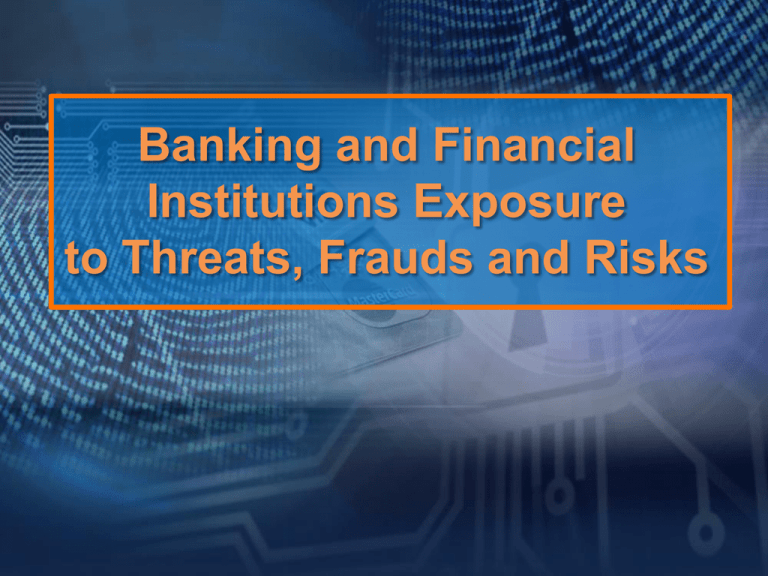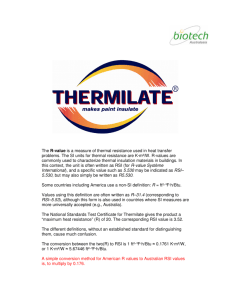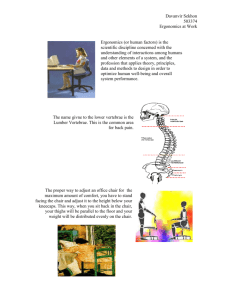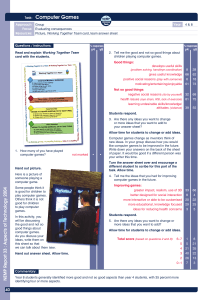
Banking and Financial
Institutions Exposure
to Threats, Frauds and Risks
Research Solutions, Inc.
Dr. Mark D. Lurie,
CEO, Threat & Fraud Assessment
The Anti-Fraud Post-Fraud Operations
(AFPFO©) Solution
Page 2
RSI, Global Threat Management Solutions
• RSI is comprised of a large, seasoned staff of exceptionally wellexperienced professional analysts and professionals that maintain
disciplines in designated areas that cover BFSI requirements, threats and
frauds.
• RSI has the only staffing that is dedicated to deal directly with “mitigation”
of threats, frauds and risks WHEN they happen.
• RSI’s GTMS group is not only experienced with domestic (United States)
based operations, but has a 35+ year track record “internationally” with
exceptional results.
• Main services:
- Systems & Process Assurance
- Governance, Risk & Compliance (GRC)
- ITE (IT Effectiveness) & Security
Page 3
RSI, Global Threat Management Solutions
(GTMS)
• Main GTMS services:
- Threat Analysis, Methodologies & Strategies
- Fraud Analysis, Methodologies & Strategies
- Risk Analysis, Methodologies & Strategies
- Complete company/agency operations auditing and evaluation
procedures
- Solutions for Prevention, Containment and Mitigation
- AFPFO Formation and Implementation
- Systems & Process Assurance
- Governance, Risk & Compliance (GRC)
- ITE (IT Effectiveness) & Security
- Automated/Manual AFPFO & ATPTO Solutions
evaluations/Recommendations
- Implementation, Training and Post-Operation Auditing
Page 4
Dr. Mark D. Lurie – Background Summary
• Over 35+ years experience in global and local anti-fraud, post-fraud think tank,
corporate strategy analysis/formation and operations/project development
• Ph.D., Business Administration, emphasis- finance, March 1978, Emphasis on
International Banking and Finance
• M.A., Business Administration, emphasis- finance, Emphasis on International
Banking and Finance
• Certified Fraud Examiner (CFE) with historical emphasis on AML, Fraud and
Threats
• Certified Threat Analyst (CTA) with historical emphasis on Asset/Personnel Threats
• Certified High-Risk Examiner (CHRE) with major emphasis on compliance,
mitigation programs, exposure levels and internal security operations
Page 5
• Sampling of Historical and Current Projects/Clients
includes, but is not limited to:
•
•
•
•
•
•
•
•
•
•
BCCI
Enron
WorldCom
Crédit Agricole S.A.
Bank of America
DuPont
Credit Suisse
BASF
Syngenta AG (SYT)
Banco Bradesco
• BNP Paribas
• Deutsche Bank AG
• DBJ Nihon Seisaku
•
•
•
•
•
Tōshi Ginkō K.K.
Fujimi Mokei
Lilly Eli and
Company
Dow Chemical
General Dynamics
J.P. Morgan Chase
Page 6
Sampling of Historical and Current Projects/Clients
includes, but is not limited to (continued):
- General Electric
- Rand Corporation
- Think-Tank – R&D Coordinator for pre-9/11 – PostHomeland Security
- State Department, FBI/PSTF and Regulatory Bureaus
- Numerous International Private/Public Sector Operations
- Systems and Procedures & Instruction for Anti-Fraud/Post
Fraud Operations
International
Finance
Corporation
(IFC)
Multilateral
Investment
Guarantee Agency
(MIGA)
International
Centre for
Settlement of
Investment
Disputes (ICSID)
UNITED
NATIONS
WORLD
BANK
GROUP
(UNWBG)
International Bank
for
Reconstruction
and Development
(IBRD)
International
Development
Association
(IDA)
Page 8
BCCI
Enron
Worldcom
PwC
Bank and
Financial
Institution
Frauds and
Major Losses
Glitnir
Bank
Arthur
Anderson
Icelandic
Central
Bank
Page 9
World Bank
What is the “World Bank”?
The World Bank consists of two distinct organizations:
• International Bank for Reconstruction and Development (IBRD)
• International Development Association (IDA).
Page 10
UNITED NATIONS WORLD BANK
GROUP (UNWBG):
What is the UNWBG?
The United Nations World Bank Group (UNWBG) Member of the “United Nations
Economic and Social Council” in conjunction with five (5) international
organizations that define and enter into leveraged loans with disadvantaged /
poor countries, which consist of the:
• International Bank for Reconstruction and Development (IBRD)
• International Development Association (IDA)
• International Finance Corporation (IFC)
• Multilateral Investment Guarantee Agency (MIGA)
• International Centre for Settlement of Investment Disputes (ICSID)
Page 11
Economic Crimes – Sample Figures
• 45% of companies worldwide have fallen victim to
economic crime
• In the past two years, the average financial damage to
companies from tangible frauds was $1.7 million
• More than half of the perpetrators were employed by the
defrauded company
• Most fraud (34%) is detected by chance
• *Taken from the Global Economic Crime Survey – 2005*, Conducted by PwC
Page 12
Examples of Financial Fraud
• BCCI ($216B+) – Shell corporations and banks; Rotation of
funds; Circumvention of internal & external regulatory
procedures; overloading (1984-1992)
• Enron ($106B+) – Parasite implants; “Mutating” internal
standards and procedures; Mirroring (i.e. Looking Glass)
operating procedures; Puffing books (2002-2006)
• WorldCom ($57B+) – Simultaneous contracting; Shell
vendors; Transparent vendors; Vapor-Payables Piggy-backing
(2002-2006)
Page 13
Examples of Financial Fraud (cont.)
• Arthur Anderson ($10.3M + Civil Litigation Re. Colonial
Realty) – Over-selling; Puffing of books; “Slip and Slide”
accounting and monitoring systems; Shell companies “fronts”
(1990-1993)
Note: Just “one” case violation
• Colonial Realty ($350M+) – Shell companies; Simultaneous
contracting; Rotation of funds; Bank processing echoes;
“Musical chairs” regulatory and procedural enforcement
operations (1990-1993)
Page 14
WHY ANTI-FRAUD/POST FRAUD METHODOLOGY
RESEARCH AND POLICY FORMATION?
Why Anti-Fraud/Post Fraud Policy Research,
Development And Implementation?
• Each year, the average company loses up to six percent* (6%) of its
revenues to internal fraud, which is also commonly known as
“employee theft”, “fidelity losses”, or “occupational fraud”.
• At a $50 million revenue company, even a 10% reduction in annual
exposure to internal fraud is worth $300,000. As fraud prevention
efforts continue year-to-year, the annual savings will likely
compound
Pursuing a Realistic Anti-Fraud Policy will result in a cost savings that
continues will-beyond the original investment for it.
*CSI/FBI Computer Crime & Security Surveys – FCPA Global Studies
Page 15
Companies and the Government Sector still “feel” that the
greatest risks are from “EXTERNAL” sources and beef up
their “outer walls” for protection. Such examples are:
•Firewalls
•Virtual Private Networks (VPN)
•Tightened Physical Security
The “Maginal Line” Defense Policy
Page 16
In Businesses and the Government
Sector, the Number One Source of
Computer Crimes is from Authorized
and Trusted Employees
(InfraGard FBI 2006 Report; CSI/FBI 2005-6; and FCPA 2005-6 results)
Page 17
Internal Computer Fraud (ICF)
62-77%* of the economic losses incurred
through “automated” (computer) crimes are
the result of “INSIDE” “authorized” employees
or contract personnel
The more knowledgeable and familiar the
insider is of the system, the higher the risk
* IIA, ICA
Page 18
Developing and Maintaining
a Successful Anti-Fraud Post-Fraud
Operation
(AFPF0)
Page 19
Premise and Goals – 6 Key Points
• The total elimination of exposure (risk) is NOT possible in any
operation. There is NO “bullet-proof” operation
• Security concerns and regulatory conformity (compliance) will
always be ever-present risks
• The “key” is to reduce exposure to acceptable levels through
consistent and valid controls within a clearly-defined AFPFO
Policy
Page 20
Premise and Goals – 6 Key Points (Cont.)
• Systems and procedures to be defined by the “policies” for
such processes and controls “requires” zero tolerance
• The business that is operationally sound through such
consistently-implemented and monitored controls and
processes will have a symbiotic relationship with “both”
internal and external auditors
• Preventative Maintenance Programs (PMP) and Preventative
Maintenance Systems/Procedures (PMSP) are the
cornerstone to a successful Anti-Fraud Post-Fraud Operation
Page 21
Anti-Fraud Post-Fraud Operations (AFPFO)
RSI
Page 22
Key Components Of An AFPFO
• A Clearly-defined Policy
• Automated Systems and Procedures
• Manual Systems and Procedures Design and Implementation
• Internal Auditing
• External Auditing
• Disaster Planning and “Recovery”
• Preventative Maintenance Systems
• Training, Education and Instruction
• Policy Challenge/Proofing
Page 23
8 STEPS to a Successful AFPFO
• Define (define the plan, the scope and the formal policy)
• Design (build a structured AFPFO)
• Challenge (analyze and validate the AFPFO internal structure)
• Approve (Critical management review and proofing)
• Implement (launch the AFPFO)
• Audit (monitor and validate effectiveness and efficiency)
• Append (fine-tune the AFPFO)
• Post-Maintenance Responsibilities and Follow-up
Page 24
Automated
Tools
–
A
Major
Compliment
Compliments to the AFPFO – Automated Tools
to a AFPFO
Benefits of Automated Tools:
• Compliance with greater speed and efficiency
• Viewing “real-time” current exception and summary reports
• Tracking potential liabilities and questionable history
• Authentication Security Solutions
• Authorization Monitoring
• Live “real-time” audit trail
• Data Protection over the WAN (target malicious users)
Page 25
Established Companies Offering
Automated Tools, such as:
• Data Cleansing
• Data Integration
• Data Monitoring
• Data Auditing
HOWEVER….
Page 26
An “Automated System” is NOT enough!
“HOWEVER, NO AUTOMATED SYSTEM WILL GUARANTEE
AGAINST A SUCCESSFUL FRAUD INTRUSION.”
Thinking that an “automated solution” is all that is needed is a
“REACTIVE METHODOLOGY” which is both dangerous and a
“guarantee” that there will be a MAJOR disaster “WHEN” the fraud
takes place.
An automated system must work with an equally-balanced MANUAL
system with “PROACTIVE” strategies in place so WHEN the fraud
takes place, it can be MITIGATED quickly, efficiently and with the
lowest loss possible.
Page 27
Copyright Notice
Warning
AFPFO and ATPTO written works are copyrighted by RSI, Dr. Mark D. Lurie and specific contributions are acknowledged appropriately
AFPFO ©1978 – 2015 RSI/MDL (all rights reserved)
ATPTO ©1978 – 2015 RSI/MDL (all rights reserved)
AFPFO™ and ATPTO™ are trademarks of RSI and Dr. Mark D. Lurie (all rights reserved)
“Fraud, Computer Fraud and Abuse Part-1” © 2015 RSI (all rights reserved) – A PowerPoint Presentation
All other works, including, but not limited to white papers, reports, analysis articles, general articles, PowerPoint presentations, streaming videos and the like (hereinafter referred to as “Intellectual
Property”) are the sole and exclusive of Research Solutions, Inc. (hereinafter referred to as “RSI”), or any of its subsidiaries. Such Intellectual Property is protected under Copyright (as well as other
Protective Acts Nationally and Internationally) with all rights reserved. Any unauthorized use of any of RSI’s (or any of it’s subsidiaries) Intellectual Property without the exclusive written permission
by RSI will be considered unauthorized and illegally reproduced and/or used.
Such unauthorized reproduction and/or use shall be prosecuted to the fullest extent of the law with all legal remedies used, whether they be national or international, including the seeking of
injunctive remedies, court costs, legal fees, expert witness fees, expenses and whatever the court(s) of law deem fit to award.
We do welcome the “proper and procedurally correct” use of our Intellectual Property; however, the following procedures are “mandatory” for consideration by RSI to approve such use
of “any” of RSI’s Intellectual Property, which is as follows: Any request for reproduction or use of any of RSI (or any of it’s subsidiaries) Intellectual Property must be made, in writing.
Such request(s) must include, but not be limited to:
The name of the Intellectual Property that is being requested to be used
The purpose of the use of the Intellectual Property
The manner in which the Intellectual Property is to be used
How the Intellectual Property is to be reproduced
For how long the Intellectual Property is be used
If the requesting party is planning to charge a fee or cost (please state the amount in United States Dollars) to other individuals, companies, institutions or agencies (nationally or internationally) for
any RSI Intellectual Property of RSI, in part or whole, and if so, the amount to be charged, the frequency of such charges and over what period of time
Research Solutions, Inc. shall review the request and will respond, in writing to the terms, conditions, restrictions, provisions and charges/costs (if applicable) for the use of such proposed RSI
Intellectual Property
If the requesting party, company or agency who made the submission for use of such RSI Intellectual Property is “approved”, such approval will be contingent upon the execution of a written
Agreement, prepared by RSI, that will reflect the terms, conditions, provisions, restrictions and charges/costs (if applicable) which must be agreed upon and executed by the requesting party “prior”
to ANY use, in ANY manner of the proposed Intellectual Property
If RSI declines the request, such declination shall be made in writing and submitted to the requesting company
If there are and costs/charges that will apply to the use of said Intellectual Property, such costs/charges shall be paid, in advance to RSI, or by whatever terms and conditions stated in the
Agreement which is executed by all parties
Research Solutions, Inc.
51 Bedford Road Roundup Montana 59072
1-406-320-1036 / 1-406-323-2992 inquiries@rsi4u.org
Page 29





